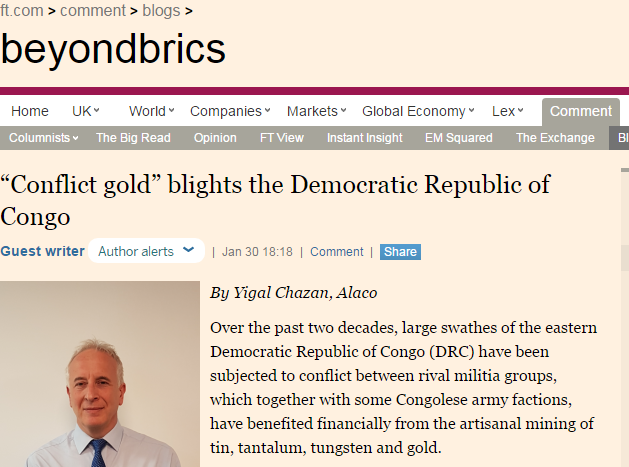24.01.2017 | ‘Conflict gold’ blights the Democratic Republic of Congo
While efforts to regulate the mining sector in DRC have made some progress, gold produced in mines controlled by armed groups continues to enter supply chains.
Click here to read the Alaco article in the FT's Beyondbrics.
Over the past two decades, large swathes of the eastern Democratic Republic of Congo (DRC) have been subjected to conflict between rival militia groups, which together with some Congolese army factions, have benefited financially from the artisanal mining of tin, tantalum, tungsten and gold.
These so-called “conflict minerals” have found their way into international supply chains serving a range of end-users – including companies in the electronics, automotive, aerospace and jewellery sectors – prompting efforts to regulate DRC artisanal mines and strengthen corporate due diligence procedures.
In a bid to increase transparency in the DRC mining sector, the authorities have since 2011 been participating in a scheme to validate artisanal mines that have no connection with paramilitaries, members of the Congolese army or human rights abuses. As of May 2016, a certification scheme – the country’s first – had undertaken 18 validation missions in the east of the country, assessing some 232 mining operations (comprising 394 mine sites). To date, 204 operations have been declared ‘green’ or ‘conflict-free’, a 31 per cent increase on 2015.
While the validation missions, including NGO and UN representatives, are unable to visit every mine, they are said to cover a large percentage of the artisanal mining mineral trade in the region. Although critics say that the inspectors need to increase the number of mines they survey and the frequency of inspections, the validation scheme is reported to have prompted improvements in security in some conflict-affected areas. Last February, research by the US NGO the Enough Project concluded that there had been a significant reduction in armed group control of tin, tantalum and tungsten (3T minerals) mining areas.
The trend was underlined in October with the publication of an inspection by the Belgium-based International Peace Information Service (IPIS) of 1,615 mines in eastern DRC between 2013 and 2015. The results showed that 77 per cent of the 390 3T mines surveyed had no connection to armed elements (local paramilitaries, militants from neighbouring countries or Congolese troops). Significantly, in 2015 a record amount of conflict-free tantalum had been exported from DRC – estimated at 948 tons, or an almost 400 per cent increase on 2013.
However, there has been little improvement in the gold sector, with the IPIS study finding that 65 per cent of the 1,220 gold mines inspected had an armed presence. Efforts to curb militants’exploitation of gold mines appear to have been less effective because many f the sites are in remote areas where paramilitaries abound. Gold is also is easier to smuggle out of the country and more difficult to trace. The UN recently said that the mineral remains by far the “most used to finance armed elements and criminal networks” in DRC.
Militants are able to profit from gold mining because of extensive smuggling networks and the prevalence of corrupt Congolese exporters. A UN report published in May 2016 found evidence of the latter ignoring due diligence requirements to source from conflict-free mines and massively under-declaring exports to provincial and national authorities.
This, it says, allows them to pay no taxes or only a fraction of what would otherwise be payable, with discrepancies of at least $174m in 2015. Traders were said to have a deliberate policy of not asking questions about the provenance of gold they acquired – that from non-validated mines is ineligible for export – and knowingly buying consignments which had clearly falsified documentation, effectively enabling the laundering of conflict gold into the international supply chain.
While a traceability system – to help companies to source conflict-free minerals – is becoming “increasingly embedded in the 3T mining sector”, the report concluded there is no such scheme for gold. That so much gold of questionable provenance is still being exported from DRC underlines the need for companies using the mineral in products to ensure their due diligence procedures are robust, particularly since recent research suggests that the measures some put in place have been found wanting.
In the US, the Dodd-Frank Act requires listed companies to determine whether their products use 3T minerals and gold from DRC or neighbouring countries, and to check whether those they have purchased have benefited armed groups. Their due diligence reports, which have to be independently audited, are then filed with the Security and Exchange Commission (SEC). In a report published last year, researchers at the University of Michigan who analysed every conflict mineral report submitted to the SEC in 2014 and 2015, found that only 1 per cent of companies were able to declare that their products were conflict-free beyond reasonable doubt, while 80 per cent admitted that they were unable to determine their minerals’ country of origin.
In 2015, Amnesty International and Global Witness reported on the findings of a joint study that examined a sample of 100 SEC reports. They concluded that 79 of the submissions failed to meet the minimum requirements of the Dodd-Frank Act and that most companies in their sample were not doing enough to map out the supply chain of the minerals they purchase.
Clearly, the DRC government needs to step up regulation of the artisanal mining sector in the east of the country. The mine validation scheme should be expanded to include more gold sites and greater efforts must be made to investigate and prosecute corrupt exporters and curb smuggling. But end-user companies also have a part to play. By strengthening their due diligence procedures, they will not only reduce their exposure to conflict minerals but help choke off a key source of funding for DRC’s militants.
(This is the text of an article first published in the FT's Beyondbrics)
- Our insight
- —Notes from the field
- —Collective intelligence
